The shape of things to come
Pharmaceutical Technology Europe
Particle shape is an important parameter to monitor in the pharmaceutical sector, but has, historically, been too complicated to measure and be utilized on a routine basis. A newly developed digital technique could change this.
Particle sizing is performed routinely in the pharmaceutical industry for quality assurance (QA), quality control (QC) and helping to understand the behaviour of particulate systems. Particle shape has, however, received much less attention, even though its importance has long been recognized by the industry. There are two main reasons for this.

The first involves the availability and accessibility of computing power. Microscopy was, and remains, the method of choice for particle shape characterization.
Previously, images of particles had to be analysed manually — an exercise that is tedious, slow and prone to errors — and the information obtained could not be fully utilized because there was neither a theoretical model nor enough computing power to handle the data. The best practical solution was to reduce the information to some shape factor that captures one aspect of the shape characteristics, but loses all the others. Such shape factors have frequently been used in conjunction with equivalent spherical diameters for nonspherical particles. This tradition has prevailed to this day, even though computer power has increased dramatically.
The second reason is that the industry has, over the years, accumulated a huge amount of historical data collected and stored as equivalent spherical sizes and simple shape factors. Internal QC procedures and various national and international standards are all based on such data. To change this tradition, three things need to happen. First, the technology of obtaining shape information must be available, affordable, easy and fast enough for routine use. Second, the technology that can make full use of shape information must exist and have demonstrable benefits that outweigh the effort and cost the industry incurs to make the switch. The third and final push is probably from the actual or anticipated change of law or standards. Although this is unlikely to happen before the first two become mature enough for practical applications, early adopters of new or innovative technologies can be, and frequently are, rewarded with a competitive edge.
In this article, methods for acquiring shape information are briefly reviewed and ways in which shape information may be used to model structures at various length scales and to subsequently predict structure-related properties are described. These generic numerical techniques have been used in sectors other than pharmaceutical. The purpose of this article is to introduce them and illustrate their capabilities to the pharmaceutical industry.
Particle shape acquisition
A prevailing view regarding particle shape has been that the industry has enough trouble making the most of the size data, which are much more readily available. Such an attitude is reflected in the market for particle size and shape analysers. There are currently more than 400 size-analysis instruments, but only approximately 10% are designed to also perform shape analysis. However, the past few years have seen a rapid increase in the number of commercial particle shape analysers, which are being updated faster than ever before and many are now 21 CFR Part 11-compliant. This is a clear indication that more attention is now being paid to particle shape by the industry as a whole.
Almost all instruments, marketed as particle shape analysers (e.g., Sysmex FIPA-3000 and PharmaVision 830 from Malvern; RapidVUE from Beckman-Coulter; CIS-100 from Galai; and CamSizer from Horiba), are essentially automated optical microscopy systems equipped with some powder dispersing mechanisms, and image acquisition and analysis capabilities. They offer a quick way to characterize particle shapes for QA and QC purposes, but fall short on providing detailed three-dimensional (3D) shape information that enables a quantitative link to be made between properties of individual particles and powder behaviour, because the instruments only capture and analyse two-dimensional (2D) projections of particles. An up-to-date review of these 2D shape analysers can be found in an authoritative book by T. Allen.1
There are several commercially available instruments that have been used to obtain 3D shape information of particles. One such instrument is the X-ray micro tomography (XMT) scanner (e.g., SkyScan 1172). It operates on the same principle as medical X-ray CT scanners, but with several important differences, including:
- the object, not the X-ray source/detector unit, is rotated
- a micro focus X-ray source with more power output capable of penetrating dense materials is employed
- nearly 1000 times higher spatial resolution (to approximately 1 µm/pixel) can be achieved
- costs only a fraction of a medical scanner.
It provides a nondestructive and noninvasive means to obtain not only the external shape, but also the internal structure of the sample.2 The main limitation of this technique, which prevents it from routine use as a shape analyser, is speed. It typically takes a few hours to scan and reconstruct a sample.
Confocal scanning laser microscopy (e.g., Radiance2100 from Bio-Rad) can also be used to help obtain 3D shapes of micron-sized particles. A key feature of this technique is its ability to obtain blur-free images at various depths. These images can then be stacked to reconstruct 3D shapes.3 Given its optical nature, the particles must be immersed in a transparent medium and the focal depth is limited. Therefore, for solid particles, it is not as versatile as XMT.
Optical profilometry (e.g., WYKO NT 3300 from Veeco) provides a quick way to obtain surface profiles of many particles in one operation.4 Profile heights typically range from less than a nanometre to a few millimetres, and the scan area can be as large as several centimetres across. Its main drawback is that only the top half of particles can be profiled, as it is usually impractical to turn individual particles around to image the other half.
Although much slower than the 2D shape analysers, these techniques do offer 3D information about shape and surface texture of real particles, which is important in understanding how fundamental properties of particles influence powder behaviour, and allow realistic computer models to be built and used to quantify the relationships.
Particle packing
A new approach has been developed to predict the behaviour and properties of powders from the fundamental properties of the individual particles.5,6 This method takes digitized real particle shapes as input to predict packing structure of powders and then uses this to predict other properties of the powders. Digitization can be performed in one of several ways: converting from CAD design data for designed objects; directly generated using computer software for mathematically describable simple shapes such as ellipsoids and cylinders; reconstructing from 2D SEM or photo images using bespoke software routines; and 3D scanners.
Figure 1(a) is an example of digitized particles of complex shapes (in this case pasta pieces) using an XMT scanner. It can be seen that both the overall shapes including cavities and the surface textures are captured. With the new solution, both the packing space (or container) and the particles are mapped in a lattice grid, and particles move one grid cell at a time following a predefined set of rules that in principle can be governed by physical laws or, as in its current version, simply a random motion plus a tendency to move in a particular direction (e.g., downwards in the case of particle settling under gravity). The use of a lattice approach simplifies collision and overlap detection between particles of complex shapes, making it easier for the algorithm to pack particles of any sizes and shapes in a container of arbitrary geometry. Thus, once digitized, complex shapes are no more difficult to handle than spheres to generate a packing structure using the new approach (Figure 1[b]).
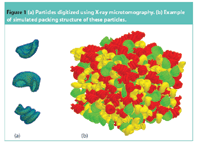
Figure1 (a). Particles digitized using X-ray microtomography. (b) Example of simulated packing structure of these particles.
The solution can be used to model packing structures at different length scales. Figure 2 shows some packing examples of relatively large, mono-sized objects. The model may be used as computer experiments to look at product–container interactions at the design stage: if particles reshaped for some other purposes can still fit in an existing container, or how a change in container geometry affects its capacity. In Figure 3, predicted and measured packing densities are compared for eight different powders (for reasons of confidentiality, their names are withheld). Up to 175 individual particles from each of the eight powders were sampled and scanned using XMT to obtain their shapes and internal porosities.
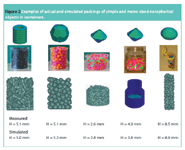
Figure 2 . Examples of actual and simulated packings of simple and mono-sized nonspherical objects in containers.
The nominal size ranges for these powders are between tens to several hundred microns. Of the eight types of powder particles, some (1, 4, 6 and 8 μm) are crystalline, and some (3 and 7 μm) are agglomerates of various internal porosity. The scanned particles are deemed to be representative of size and shape distributions for each powder, and duplicated many times to make up the feedstock (containing several thousand particles) for each packing simulation. Periodical boundary conditions are used to minimize wall effects. For all the simulations, the standard deviation of predicted bulk packing density is less than 0.002.7
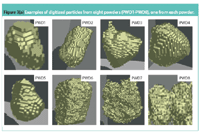
Figure 3(a). Examples of digitized particles from eight powders (PWD1-PWD8), one from each powder.
Achieving uniform blending is a recurring problem in drug production. Currently, the design and operation of blenders are largely based on empiricism. The industry has learnt through experience that an effective way to minimize segregation of a free-flowing powder is to keep the size range of different components as close to each other as possible. However, unless the particles are also of identical shape, there is no guarantee that controlling the nominal size alone will always work. The 2D simulations results, summarized in Table 1, demonstrate that particles of the same equivalent area size have a varying tendency to segregate according to their shape and the tendency is not a monotonic function of any of the commonly used shape factors (e.g., circularity and aspect ratio). Here, the tendency to segregate is quantified by the number (N90%) of shakes required for an initially well mixed particle assembly to become 90% segregated. The bed is said to be 90% segregated when 90% of the particles in a layer are of the same shape.

Figure 3(b). Comparison between predicted and measured packing density for each powder.
Prediction of properties
The predicted packing density can be related to powder flowability and compressibility. Once the packing structure has been obtained, it is also possible to predict structure-related properties such as conductivity,8 permeability9 and dissolution.
Drug dissolution is an important issue for the pharmaceutical industry, which currently takes an essentially empirical approach.10 Work is being performed by the authors to develop a mesoscale model where the influence of particle size and shape on the microstructure of granules and tablets and their dissolution rate can be assessed numerically. For tabletting, the ultimate goal is a new solution-based numerical model, which links fundamental properties of the excipients and incipients, such as initial packing and subsequent compaction, to the structure of the tablets.

Table1. Results of 2D segregation simulations of binary mixtures containing 200 circles and 200 equal-area non-circular particles.
For dissolution, the starting point is a digitized microstructure of mixed components. A diffusion–convection equation is then solved for each component using a finite difference scheme, with the classic Noyes–Whitney equation as the boundary condition at the solid–liquid interface. The flow field can be obtained independently (e.g., from computational fluid dynamics [CFD] simulation or measurement) and used as input to the dissolution model. The digitized structure may be a simulated virtual structure, or a real structure imaged using XMT. In either case, the different components are identifiable and can be given different dissolution related properties (e.g., density, dissolution coefficient, diffusion constant and saturation concentration). Ultimately, the dissolution model also aims to incorporate the processes of disintegration (of the tablet into granules) and deaggregation (of the granules into fine particles).
The above approach is illustrated with a hypothetical example shown in Figure 4. The two primary particles, both of an equivalent–volume size of 12 μm, and the agglomerate, of 20 primary particles, are generated using the solution. To demonstrate how particle shape influences the dissolution rate, the two components are given identical mass density (1250 kg/m3 ), diffusion constant (1.0×10-10 m2 /s) and dissolution coefficient (1.0×10-4 m/s). Figure 4(a) compares the dissolution profiles of standalone primary particles and the granule under diffusion-only conditions, whereas in Figure 4(b) convection with a maximum of velocity of 0.1 mm/s is also present.
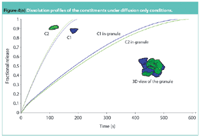
Figure 4(a) . Dissolution profiles of the constitments under diffusion only conditions.
The flow field is computed and continually updated during the dissolution (erosion) process, using a numerical technique called Lattice Boltzmann Method,11 which is a digital equivalent of the conventional CFD and adept at simulating flow distribution through porous media. Figure 4 clearly demonstrates that particles of equal volume, but different shapes dissolve differently and their packing structure also has an influence on the dissolution kinetics. This numerical approach can be applied at several different length scales — the whole tablet, individual granules and primary particles — to assess at how shape, internal (porous) structure affect the overall dissolution rate with or without a superimposed flow field.
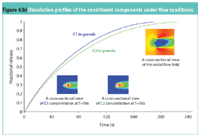
Figure 4(b) . Dissolution profiles of the constituent components under flow conditions.
Conclusions
The digital approach has been demonstrated to have the ability to make full use of 3D shape information and has the potential to be a valuable tool for process engineers in the pharmaceutical industry to better understand the effects of particle size and shape on the packing structure and structure-related properties. Further developments in these areas can be anticipated.

Key points
References
1. T. Allen, Powder Sampling and Particle Size Determination (Elsevier Science, London, UK, 2003).
2. J. Baruchel et al., X-ray Tomography in Material Science (HERMES Science Publications, Paris, France, 2000).
3. A. Lamprecht, U. Schafer and C.M. Lehr, AAPS PharmSciTech1(3), article 17 (2000).
4. V. Bullman, J. Mic.211, 95–100 (2003).
5. X. Jia and R.A.Williams, Powder Technol.120, 175–186 (2001).
6. X. Jia and R. Williams, UK Patent Application P888399B (2001).
7. M. Gan et al., KONA Powder and Particle22, 82–93 (2004).
8. X. Jia, G. Gopinathan and R.A.Williams, Adv. Pow. Tec.13(1), 55–77 (2002).
9. C. Selomulya, X. Jia and R.A Williams, Chem. Eng. Res. Des.83(A7), 844–852 (2005).
10. R. Hanson and V. Gray, Handbook of Dissolution Testing, 3rd Edition (Dissolution Technologies Inc., Hockessin, Delaware, USA, 2004).
11. S. Succi, The Lattice Boltzmann Equation: For Fluid Dynamics and Beyond (Oxford University Press, Oxford, UK, 2001).
Xiaodong Jia is senior research fellow, Richard A Williams is a professor, both at the Institute of Particle Science and Engineering, School of Process, Environmental and Materials Engineering, University of Leeds,UK.

Pharmaceutical Tariffs Are Imminent: How Industry is Bracing for Impact
April 16th 2025On April 14, 2025, the Trump Administration launched a national security-driven investigation into pharmaceuticals, a move that will likely result in tariffs being placed on pharmaceutical drugs, ingredients, and other components that are imported from outside of the United States.